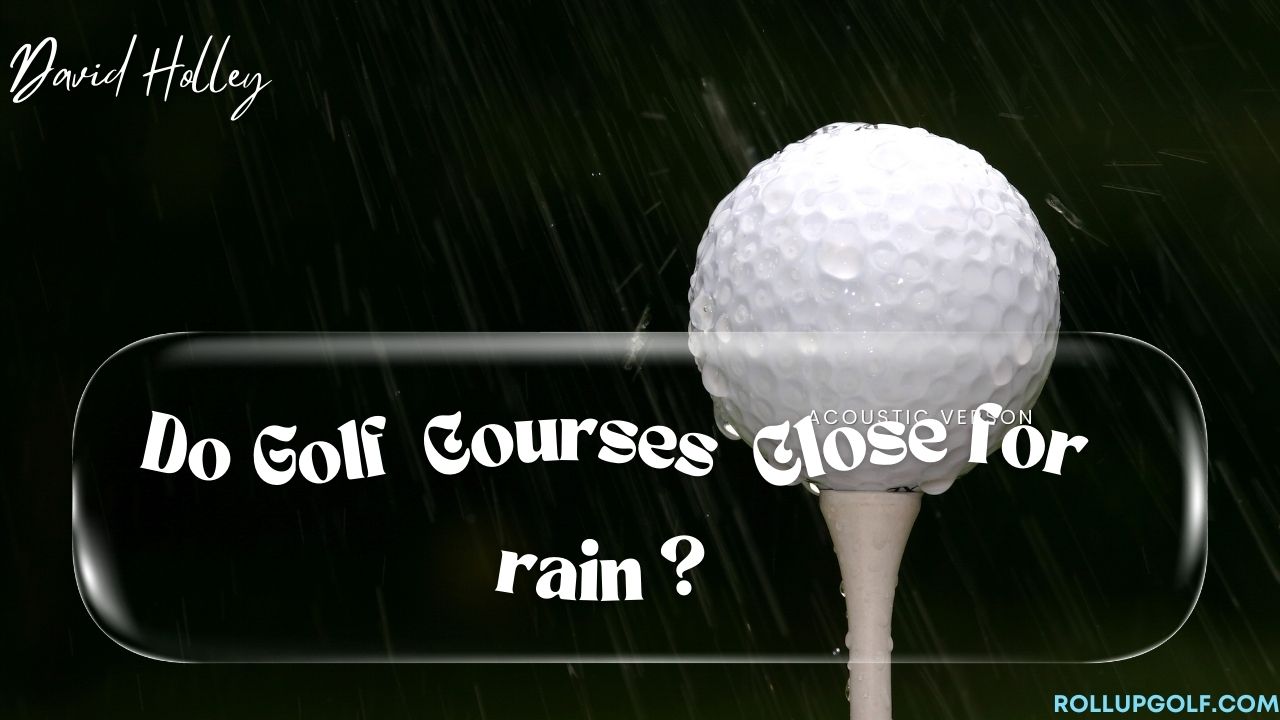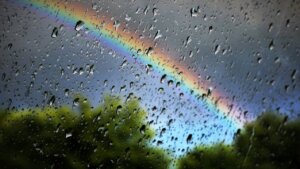
Golf, a sport often associated with sunny skies and meticulously groomed fairways, occasionally faces the challenge of inclement weather. Rain, in particular, can significantly affect the playing conditions and safety of golf courses. So, the question arises: do golf courses close for rain?
Read also: How Tall is a Golf Cart with a Roof?
Do Golf Courses Close for Rain?
Whether golf courses close for rain depends on several factors:
The severity of the rain:
- Light rain: Most courses stay open for light rain, as long as there’s no lightning or severe wind. Players can adapt with rain gear and adjusted strategies.
- Heavy rain: If the rain is heavy and sustained, causing flooding or making the course unplayable, then closure is likely. Player safety and course maintenance are prioritized.
Other factors:
- Lightning: Always a no-play situation due to safety concerns.
- Course drainage: Courses with good drainage systems are more likely to stay open for moderate rain.
- Player demand: If there are few players and conditions are borderline, closure might be considered.
- Course rules and policies: Some courses have specific rain closure policies.
Checking for closures:
- Course website or social media: Most courses update their status online.
- Golf directories: Platforms like GolfNow or TeeOff.com often list course closures.
- Calling the course directly: The most reliable source for real-time information.
Remember, even if a course is open during rain, the playing experience might be different:
- Limited visibility: Reduced distance and slower greens affect strategy.
- Wet conditions: Slippery ground and mud can impact playing comfort.
- Course damage: Heavy rain can lead to temporary closures for repairs.
Ultimately, safety and course preservation are top priorities. So, while golfers embrace challenges, unplayable conditions due to extreme rain will result in closures.
Can you play golf if it’s been raining?

Whether you can play golf if it’s been raining depends on several factors:
Safety:
- Lightning: This is the most important consideration. Never play golf during a thunderstorm or if there’s any chance of lightning. Metal clubs act as conductors, making you a target.
- Course conditions: Heavy rain can flood parts of the course or make the ground too soft for safe play. Check with the course itself for their decision on closures or limitations.
Enjoyment:
- Amount of rain: Light rain might be manageable with proper gear, but heavy rain can be uncomfortable and make the game less enjoyable.
- Your tolerance for wet weather: Some people don’t mind getting wet, while others prefer to play in dry conditions.
Playing considerations:
- Ball distance: Rain-soaked ground will absorb more impact, reducing your ball’s distance. Be prepared to adjust your club selection.
- Grip: Wet hands and clubs can make gripping difficult. Use rain gloves for better control.
- Greens: Soft greens can hold the ball more, affecting putting speed. Aim for firmer, flatter areas.
- Visibility: Low visibility in heavy rain can make it hard to see the ball. Consider using brightly colored balls.
Overall:
Playing golf after rain can be done, but it requires careful consideration of safety, your personal comfort level, and adjustments to your game.
For the best decision, I recommend checking with the specific golf course you want to play at. They can advise on current conditions, closures, and any recommendations for playing in wet weather.
How do you golf In the rain?
Playing golf in the rain can be challenging but rewarding! Here are some tips to stay safe, and dry, and even improve your game:
Before you head out:
- Check the weather: Ensure no lightning is forecasted and understand the rain intensity. Light rain is manageable, but heavy downpours might be best avoided.
- Dress the part: Layer up with waterproof clothing and wear a wide-brimmed hat. Opt for soft-spiked shoes for traction.
- Gear up: Pack rain gloves, an umbrella with a double canopy, extra towels, and a dry change of clothes. Consider using brightly colored golf balls for better visibility.
Staying dry and comfortable:
- Keep your hands dry: Rain gloves are essential for maintaining grip. Dry your hands and gloves frequently with towels.
- Protect your clubs: Use a rain hood for your bag or cover your clubs with a towel when not in use.
Adjusting your game:
- Club selection: Expect reduced distance due to wet ground. Choose one club higher than usual for most shots.
- Ball flight: Adjust for lower trajectory and less roll due to heavier air and softer ground.
- Swing mechanics: Focus on maintaining rhythm and tempo. Avoid aggressive swings that can lead to loss of control.
- Putting: Slower greens hold the ball more. Hit putts firmer and aim for flatter areas.
- Course management: Play safe shots and avoid difficult lies in wet rough. Utilize the “lift, clean, and place” rule if applicable.
Additional tips:
- Stay positive: Embrace the challenge and focus on enjoyment, not score.
- Be courteous: Respect other golfers by keeping pace and maintaining good etiquette.
- Listen to your body: If you’re getting too cold or uncomfortable, don’t hesitate to call it a day.
Remember, safety is paramount. If the conditions worsen or you feel unsafe, don’t hesitate to stop playing and seek shelter.
By following these tips, you can have a fun and memorable golfing experience even when the weather doesn’t cooperate!
Do professional golfers play in the rain?
Yes, professional golfers do play in the rain under certain circumstances. Professional tournaments rarely get postponed solely due to rain, unless there are safety concerns like lightning or extremely heavy downpours. However, their game does adapt to the wet conditions:
Safety first:
- Tournaments will only proceed if conditions are safe for players and spectators. This includes no lightning threats and playable course conditions.
Adjusting to the elements:
- Clothing: Rain gear including waterproof jackets, pants, hats, and gloves becomes essential.
- Equipment: Clubs might be covered with rain hoods, and players might switch to different balls for better visibility.
- Strategy: The game requires adjustments like choosing different clubs for reduced distance, aiming for flatter areas on greens, and adjusting swing mechanics for grip and control.
Challenges and opportunities:
- Rain presents challenges like reduced ball distance, slower greens, and potential visibility issues.
- However, some players thrive in the rain as it can slow down the field and reward adaptability and precise strategy.
Examples:
- Many iconic tournament moments occurred in rainy conditions, showcasing players’ skills in adapting to the elements.
- The 2013 Open Championship saw Phil Mickelson famously win in pouring rain.
Overall:
- While professional golfers prefer ideal weather, they are trained to handle rain and often embrace the challenge it presents.
Remember, specific decisions on playing in rain depend on tournament rules, safety assessments, and individual player preferences.
Do golf courses close in the winter
not all golf courses close in the winter. Whether a course closes depends on several factors, including:
Climate:
- Warm climates: Courses in places like Florida or Arizona typically stay open year-round.
- Temperate climates: Courses in regions with mild winters like California or the Pacific Northwest may have reduced hours or amenities, but often stay open.
- Cold climates: Courses in areas with harsh winters like Canada or Minnesota will likely close for the season.
Course type:
- Public courses: Often have set closing dates based on weather and business considerations.
- Private courses: They may have more flexibility and stay open longer, depending on member preferences.
Management decisions:
- Some courses may close earlier or later than usual based on:
- Weather conditions: Unexpected snowfall or extreme cold snaps.
- Business considerations: Lower demand during the holidays.
- Maintenance needs: Scheduling renovations or repairs.
Here’s a quick summary:
| Climate | Public Courses | Private Courses |
|---|---|---|
| Warm | Usually open | Usually open |
| Temperate | May close late fall/early winter | May close later, depending on the location |
| Cold | Usually close November-March | Some may stay open longer |
To know for sure if a specific course is closed:
- Check their website or social media.
- Use a golf course directory like GolfNow or TeeOff.com.
- Call the course directly for the most accurate information.
Remember, even if a course is open, the playing experience might be different in winter:
- Reduced hours or amenities due to shorter daylight hours.
- Frost delays or cancellations due to cold weather.
- Course conditions may be wet, muddy, or snow-covered, affecting playability.
I hope this helps!
Read also: What Are Golf Shirts Made Of?
when do golf courses close for the season
The closing time for golf courses varies greatly depending on several factors, including:
- Climate: Courses in warmer climates like Florida or Arizona may stay open year-round, while those in colder regions like Canada or Minnesota will close for the winter.
- Course type: Public courses are more likely to have set closing dates, while private courses may have more flexibility.
- Management decisions: Some courses may close earlier or later than usual based on weather conditions, business considerations, or maintenance needs.
Here’s a general overview of golf course closing times in different regions:
- Warm climates: These courses typically stay open year-round, although they may have reduced hours or amenities during the hottest or coldest months.

Warm climates - Temperate climates: Courses in these regions typically close sometime between late fall and early winter, and reopen in the spring. The exact timing varies depending on the specific location.

Golf course in temperate climate - Cold climates: Courses in these regions typically close for the winter, sometime between November and March. The exact timing varies depending on the specific location and the severity of the winter.

Here are some resources that you can use to find out when a specific golf course is closed for the season:
- The course’s website or social media: Most courses will list their hours of operation and closing dates on their website or social media pages.
- Golf course directories: Online directories like GolfNow or TeeOff.com often list the closing dates for courses in their database.
- Calling the course directly: The course itself is always the best source of information about their closing dates.
I hope this information is helpful!
Importance of Weather in Golf
Golf is an outdoor sport highly sensitive to weather conditions. While a sunny day with a gentle breeze might provide ideal playing conditions, rain can pose significant challenges. Not only does rain affect the grip and flight of the ball, but it also impacts the safety of players and the condition of the course itself.
Decision-Making Process for Closing Golf Courses
Factors Considered
Golf course managers and administrators carefully consider various factors before deciding to close a course due to rain. These factors include the intensity and duration of the rain, the condition of the turf, and the likelihood of lightning strikes.
Safety Concerns
Player safety is paramount in the decision-making process. Lightning poses a serious risk to golfers out on the course, and if thunderstorms are forecasted, courses may close preemptively to avoid potential danger.
Course Conditions
Heavy rain can saturate the turf, leading to waterlogged fairways and greens. This not only affects the playability of the course but also risks causing damage to the turf, which could require extensive repairs.
Policies and Practices Regarding Rain Closure
Varying Policies
The decision to close a golf course due to rain varies depending on the policies of individual courses and clubs. Some may have specific guidelines dictating when the course should be closed, while others may leave it to the discretion of the course superintendent or manager.
Communication with Players
Effective communication with players is essential when a course is closed due to rain. Courses typically use various channels such as email, social media, and website updates to inform players of closures and any subsequent changes to the schedule.
Read aslo: What Are Golf Shirts Made Of?
Alternatives to Closure
Delayed Start
In cases where the rain is expected to be temporary or light, courses may opt for a delayed start rather than a full closure. This allows time for the rain to pass and for course, maintenance crews to assess and prepare the course for play.
Partial Closure
Another option is a partial closure, where certain holes or sections of the course are closed while others remain open. This allows players to still enjoy a round of golf while minimizing damage to the course.
Temporary Greens
In extreme cases where the rain is persistent and severe, courses may implement temporary greens on unaffected areas of the course. This allows play to continue without risking damage to the main greens.
Impact of Rain Closure on Players
Frustration and Disappointment
For avid golfers, a rain closure can be disappointing, especially if it disrupts a planned round or tournament. However, understanding the necessity of the closure for safety and course maintenance can help alleviate frustration.
Understanding the Decision
While it may be tempting to question why a course is closed for rain, it’s essential for players to trust the expertise of course management. The decision to close a course is made with the best interests of players and the course’s long-term health in mind.
Conclusion
In conclusion, golf courses do indeed close for rain, with the decision based on a careful assessment of safety concerns and course conditions. While closures may inconvenience players, they are necessary to ensure both player safety and the integrity of the course. Effective communication and alternative options can help mitigate the impact of rain closures on players’ enjoyment of the game.
FAQs:
- Can I still play golf if the course is closed due to rain?
- Typically, no. Courses close for rain to protect player safety and the condition of the course. It’s best to respect the closure and wait for better weather.
- How do golf courses decide when to close for rain?
- Courses consider factors such as the intensity and duration of the rain, the condition of the turf, and safety concerns like lightning strikes.
- Do all golf courses have the same policies for rain closures?
- No, policies vary depending on the course and club. Some may have specific guidelines, while others leave the decision to course management.
- What happens to scheduled tee times if the course closes for rain?
- Courses typically inform players of closures and may offer rescheduling options or refunds for canceled tee times.
- Can golf courses reopen after rain closures?
- Yes, once conditions improve and it’s safe to do so, golf courses can reopen for play. However, it may take time for the course to dry out and return to optimal conditions.








